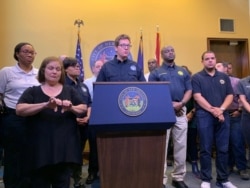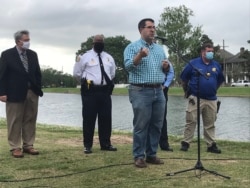“It’s embarrassing,” Joe Frisard told VOA regarding the condition of infrastructure in his hometown of New Orleans, Louisiana. “We’re a major city that hosts Super Bowls, we’ve got an NFL team and an NBA team, and we put on major, world-class music festivals — but I don’t think you could find a six-block stretch of road here that doesn’t have something wrong with it.”
Americans have been discussing infrastructure for the last several months as President Joe Biden and Democrats in Congress attempt to pass a nearly $2 trillion bill that would address what politicians in both parties acknowledge is an aging network of roads, bridges and water systems badly in need of an upgrade.
Among New Orleans locals, however, the state of the city’s infrastructure system has been a point of conversation for decades — as common as a discussion about favorite restaurants or the next festival on the calendar.
Frisard pointed out a pothole two blocks from his house so large someone placed a child’s car into it.
“This isn’t like a little remote control toy car, either!” he laughed, frustrated. “Look — it can fit a mini engine inside!”
For New Orleanians like Frisard, sometimes all they can do is laugh. Residents often decorate the longtime potholes on their blocks, and social media accounts have been created to honor giant traffic cones placed in front of hazards or to advertise “waterfront property” when the city’s streets flood.
“People have a sense of humor about it, but it’s not so funny when cars and homes flood during just an average summer rainstorm or when we have to boil our drinking water because our water system fails multiple times a year,” he said.
“I mean, who else in America has to do this? Don’t we say we’re the richest country in the world? But we can’t provide safe drinking water?” he added.
Crumbled infrastructure
New Orleans has unique challenges that make maintaining the infrastructure especially difficult. Chief among those obstacles is that the city sits atop alluvial soil — land created by thousands of years of Mississippi River flooding. Each time the river overflowed its banks, more sediment was deposited, creating the land on which the city and its surrounding population centers now sit.
Unfortunately for New Orleans’ residents and government officials, alluvial soil is always shifting, helping to create the city’s infamous cracked roads and potholes.
But damaged roads are far from New Orleans’ only infrastructure challenge. When President Biden visited the city last month to promote his infrastructure plan, city officials highlighted what many consider to be the city’s biggest infrastructure challenge.
“We took him to our more-than-100-year-old sewerage and water board facility,” said Ramsey Green, deputy chief administrative officer for infrastructure in New Orleans. “This facility is charged with keeping our city’s residents safe from all of the flooding and other climate-related challenges we face today, but it was built when Woodrow Wilson was president.”
Green and others toured the facility with President Biden. They explained how even though an improved levee system has helped mitigate the risk of water from outside flooding — as was the case during Hurricane Katrina in 2005 — their aged system still struggles with pumping out water from within during heavy rainfall.
“It’s not that we’re seeing more rain now,” Green said when asked about the city’s pump system, “it’s that we’re seeing more condensed periods of rain. When you get 12 inches of rain in six hours, unless you’re on a mountaintop, you’re going to get some flooding.”
City officials say they need federal funding to help bolster the system. Green is hopeful the president’s infrastructure plan can do just that.
“We have a long list of green infrastructure projects that can help prevent future flooding by, for example, providing spaces in the city where excess water can be safely stored,” he said. “But then we also have pumps and pipes that are more than a century old that need to be replaced.”
Less than a week after President Biden visited the city, a tornado struck. A series of repairs resulted in a drop in pressure that made the local water supply unsafe for drinking. For approximately two days, residents were instructed to boil all water in order to avoid ingesting dangerous bacterial contaminants.
“If we had invested in more reliable power sources, including solar power, then the boil-water advisory wouldn’t have occurred,” Green said. “And if we had invested in an improved pipe system, it wouldn’t have occurred either.”
Competing definitions
“In New Orleans, the issue is especially acute because so much of our city is below sea level,” said Joe Giarrusso III, one of seven elected officials on the New Orleans City Council. “But this issue of aging infrastructure is something Americans are facing all over the country. This is our chance to make some major improvements.”
But those improvements are going to be costly. Giarrusso said just fixing all of New Orleans’ surface and subsurface infrastructure issues would cost about $9 billion.
To pay for his plan, Biden has suggested raising the corporate tax rate from 21% to 28%. According to an April poll by Morning Consult/Politico, nearly two in three voters said they support raising the corporate tax rate to pay for infrastructure improvement, including half of Republican voters with an opinion on the issue. Still, the tax increase remains a nonstarter for congressional Republicans.
“This is not a partisan issue among voters because it’s something we can all agree on. It’s good for public safety, it makes our quality of life better and it will create jobs,” Giarrusso told VOA.
But the plan has met some resistance from Republicans in Congress who believe Biden’s plan extends far beyond the scope of traditional infrastructure projects.
“Only 5% of it is infrastructure,” Sen. John Kennedy, a Republican from Louisiana, told reporters after the president’s visit. He said projects addressing bridges, water, ports and broadband should be the focus of the bill. “The rest is the Green New Deal, new welfare programs and reparations. Asking me to vote for this bill when it’s only 5% infrastructure and 95% noninfrastructure is like asking me to buy a car to get the cup holders.”
But Democrats like Giarrusso say including initiatives that address affordable housing, and child and elderly care under the umbrella of infrastructure makes sense.
“Giving people better housing is infrastructure,” he said. “These kinds of things are investments in our communities just as important as bridges and roads.”
Passing a bill
For an infrastructure bill to pass the evenly divided U.S. Senate, all Democrats must vote in favor, as well as at least 10 Republicans. That difficult scenario may have become a bit more likely Friday when a group of 10 Democrats and Republicans, including Louisiana Sen. Bill Cassidy, put forward an infrastructure bill that would cost approximately $1 trillion.
But getting colleagues to go along with their proposal remains a challenge. The draft bill focuses on traditional physical infrastructure and falls well short of the size of the president’s proposal. That could make it hard to convince enough Democrats, while the $1 trillion price tag is still large enough to make many Republicans hesitant.
If Democrats are unable to pass a bill, they would still be able to execute the Biden plan through a process called budget reconciliation. This, however, would require all 50 Democratic senators to go along, and Democratic Sen. Joe Manchin of West Virginia has already expressed reservations.
But Frisard, of New Orleans, doesn’t think regular Americans care how it gets done. He said the city deserves better.
“You’d have a hard time finding a group of people prouder of their city than New Orleanians, which is amazing to me, because we put up with so much crap to live here,” he said. “I’m tired of having guests or tourists come into town, and I have to explain why we’re boiling our water or why the roads are so bad. This country has the money to fix this, and we deserve that.”










